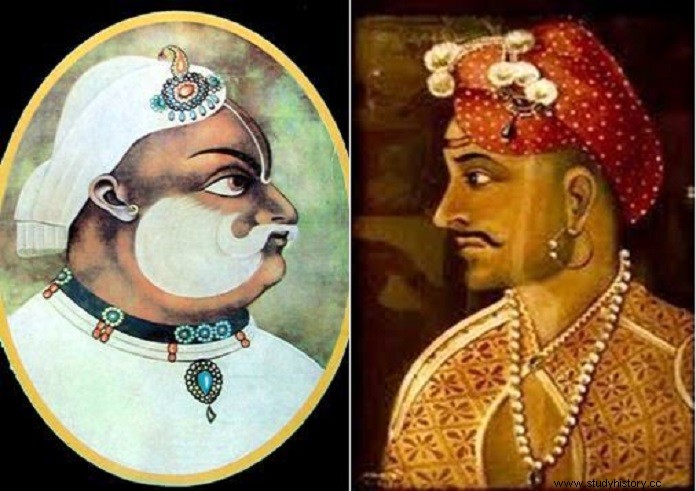
When Safdarjung went to Awadh, the Maratha army under the leadership of Malharrao Holkar's son Khanderao set foot in Rajputana. He went straight to the princely state of Jaipur and asked for tax from Raja Madho Singh there. Taking taxes from Madho Singh, the Marathas proceeded towards the princely state of Bharatpur. King Surajmal handed over the charge of protecting Bharatpur to Jawahar Singh and himself sat down in the fort of Kumher. It was a surprise that a few days back Surajmal and Marathas had fought unitedly in the campaign made by Safdarjung against the Ruhals, but today the same Marathas had come to punish Surajmal for the help given by Surajmal to Safdarjung. In fact, the wealth of the Marathas was working behind it. The Marathas knew that Surajmal had looted a huge treasure from Delhi, the Marathas wanted that treasure.
Surajmal sent a proposal of friendship to Khanderao, but Holkar's general Raghunathrao placed a demand of two crore rupees before Surajmal. Surajmal's minister Roopram agreed to give Rs. 40 lakh but Malharrao Holkar, who was in Jaipur at that time, told that Jats should give more than Rs. 2 crore. Angered by this, Surajmal sent five cannon shells and a little gunpowder to the Maratha general Raghunathrao and asked him to either take forty lakh rupees or be ready to face the consequences.
On this in January 1754, the Marathas besieged Kumher. The Mughal army also joined them. At this time there were 80 thousand soldiers in the army of Surajmal's enemies. The Marathas burnt all the crops to ashes in a circle of fifteen miles around Kumher. All the roads leading to Kumher were closed and took possession of Hodal. The armies of Imadulmulk, Khanderao, Raghunathrao and Malharrao surrounded Surajmal badly. With the Mughals and Marathas becoming enemies and Jaipur becoming neutral, Raja Surajmal was left alone in the whole of North India but he did not give up. King Madho Singh of Jaipur did not want him to contribute in destroying the kingdom which his ancestors had established with their own hands. On the other hand he did not want to annoy the Marathas either. So he sent a small Kachhwaha army with the Marathas. King Surajmal fought this combined army for four months.
One day, while Khanderao was inspecting the trenches excavated outside the fort, Khanderao was killed by a cannon fired inside the fort. His nine queens became sati with his dead body. His queen Ahilyabai could not commit sati because she was pregnant. The son became mad in mourning, Malharrao vowed that he would destroy the Jats completely. Now the Marathas made the attacks on Kumher terrible. In such a situation, Surajmal's queen Hansia gave Surajmal's turban and a letter to Tejram Kataria, son of Rupram, and sent it to the Scindia Raja of Gwalior. Scindia was with Holkar at that time. When Scindia got the offer of Queen Sneakia, he sent his turban, an encouraging letter and a bilvapatra of his Kuldevi's prasad to the queen in return. When Malharrao came to know about the correspondence between Hansia's correspondent and Scindia, his spirits were broken.
When the Marathas could not exert enough pressure on the Jats, Wazir Imadulmulk called for help from Delhi. The emperor felt that if the Marathas broke Kumher, then the immense wealth of the Jats would be in the hands of the Marathas. That's why he did not send an additional army. Due to all these reasons, the Marathas found the bet going out of their hands. He made a pact with Surajmal. Surajmal assured the Marathas through Rupram Kataria that he would give thirty lakh rupees to the Marathas in three years but he gave only two lakh rupees. The Marathas lifted their siege and went to the Deccan. Surajmal's reputation was blown away by this success. The Mughal vizier Imadulmulk, beating his head, went to Delhi where he beheaded Emperor Ahmad Shah, imprisoned him and got him killed.
Treaty with Najeeb Khan
Surajmal and Jawahar Singh captured Palwal and Ballabgarh as soon as the Marathas left. These areas were under the control of Marathas at that time. In June 1755, the Mughal general Najib Khan campaigned to take back the areas of Ganga-Yamuna do-Aab which had been captured by Suraj Mal. On this Surajmal sent a proposal for a treaty to Najeeb Khan and a treaty was signed between the two sides. The terms of this treaty were as follows-
1. The areas in Aligarh district which were ruled by Raja Surajmal, will remain with Surajmal.
2. The fixed revenue on these lands was fixed at twenty six lakh rupees, out of which eighteen lakh rupees were to be reduced by the cash compensation of those jagirs which had been given to Surajmal by Khoja Javid Khan during the reign of Ahmad Shah but due to the continuous unrest of those days. Reasons which could not be properly transferred.
3. Surajmal will vacate the fort and district of Secunderabad which was given to him by the Marathas.
4. Out of the remaining eight lakh rupees which was to be received by the royal treasury, Surajmal would pay two lakh rupees at the time of signing the Dasna-Pact and the remaining six lakh rupees in a year.
Raja Badan Singh passes away
Due to the loss of his eyesight, Badan Singh had left the official work on Surajmal. In the last days of his life, Raja Badan Singh went to Sahar where he died on 7 June 1756.
